Photos (from left): Ebet Roberts/Redferns via Getty Images; Mairo Cinquetti/NurPhoto via Getty Images; Gary Miller/Getty Images; Brian Rasic/WireImage.
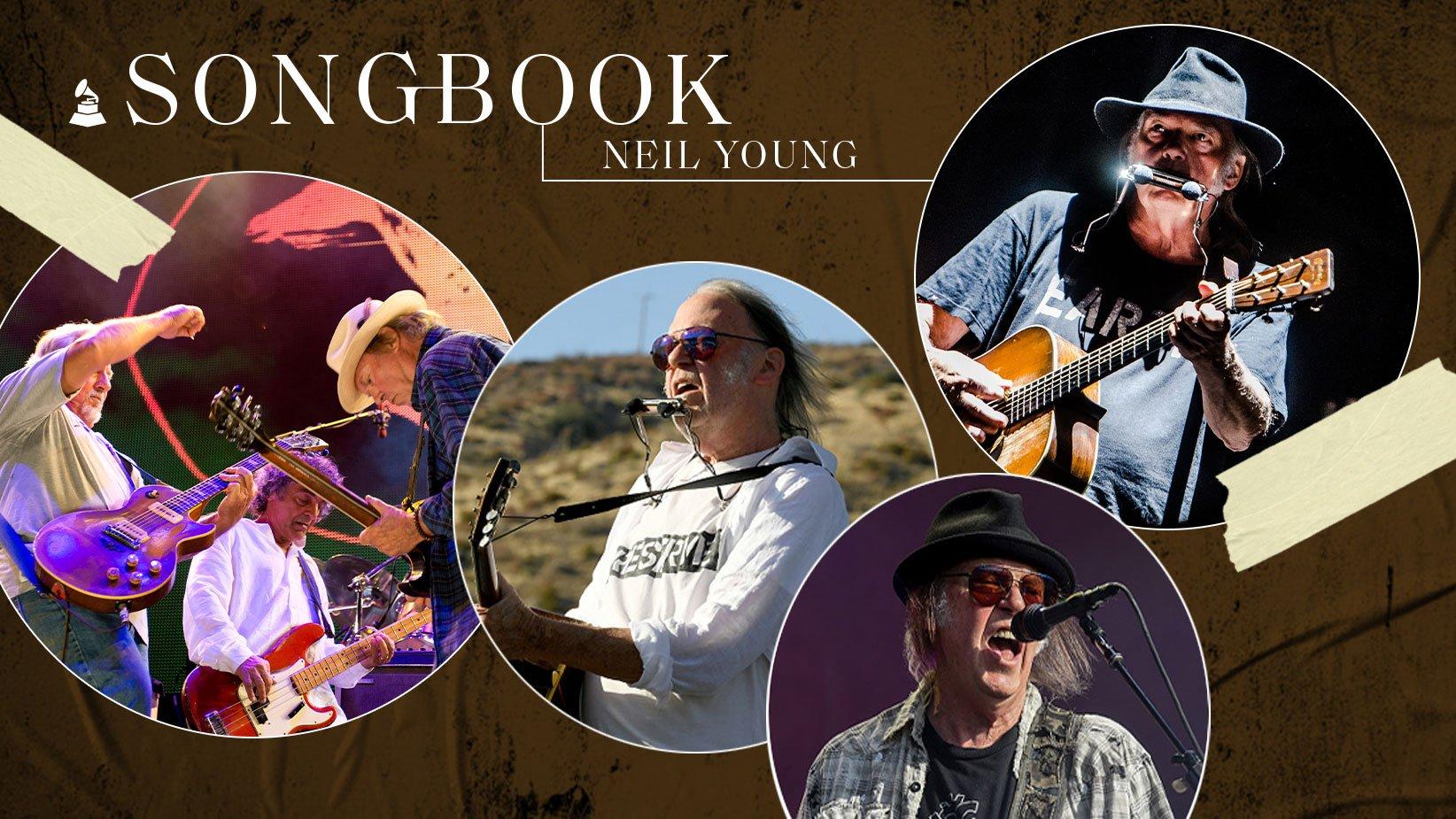
list
Songbook: Inside Neil Young's Latest Decade And Change, From 'Americana' & 'Psychedelic Pill' To 'Barn' & 'World Record'
Neil Young's resonance and relevance extends far past his '70s commercial heyday; his past decade of albums have been some of the most rich and rewarding of his career. And his GRAMMY-nominated documentary 'Barn' shows that.
In Conan O'Brien's eyes, Neil Young has done the impossible.
"He's managed to stay completely authentic and raw in a way that almost seems impossible to me," O'Brien told Howard Stern last year. "What he was doing with Buffalo Springfield in [1966], he's still going for that. He hasn't calcified. He hasn't crusted over. He's still going for that. So that guy blows me away.”
It's not the first time Young has blown O'Brien's mind. When the two sat down for an interview a few years ago, the comedian expressed his admiration for Young's ability to "not give a s—." To which Young replied, "If somebody doesn't like something, that's just as exciting as them liking it." O'Brien's response? "My head just came off."
Such are the twin halves of the two-time GRAMMY winner's artistic journey in his 70s: indomitable will and an almost supernatural ability to brush off criticism.
Powered by undiluted passion, moral will-to-power and an unscratchable creative itch, Young is always hurtling forward, prioritizing honesty and raw feeling over all else. ("There's a lot of people who do like it, and they'll like it even more if you didn't guard the edges," Young told O'Brien in the same interview — cogent advice for every creative person in the self-censoring 2020s.)
Key figures in Young's life and career — like filmmaker Larry L.A. Johnson, pedal steel guitarist Ben Keith, former wife Pegi Young, and manager Elliot Roberts — have passed away in the last decade and change; in decades past, he lost producer David Briggs and Crazy Horse guitarist Danny Whitten, among so many others. These losses haven't thrown Young off the rails, but seemingly added momentum to his runaway creative train.
This alchemy — his innate ability to process trauma, negativity and loss into quantum motivation — popped up in 2019, when an anonymous fan wrote a letter to Young's quirky online newspaper, the Times-Contrarian. The fan talked about their "Uncle Eddie," concerned that the ailing 76-year-old won't live to hear all of the archival music Young promised he has in the can.
"He wants to know why you don't just put all this material out now. Just dump it all out on the NYA website," they entreated. "He wants you to know that he can't buy it if he's dead." Young sprang into action, and there's now a plethora of lost recordings out there — Homegrown, Summer Songs, Toast — with an untold ocean of music to come.
Amid the archival deluge, Young's latest decade-plus of music making has been one of the most satisfying epochs of his long career — his lyrical messages heartfelt and probing, his production raw and wooly, his electric guitar playing more twisted and brain-bending than ever.
These components of his current run are fully on display in the documentary Barn — which captures the recording process for 2021's Barn — for Best Music Film at the 2023 GRAMMYs. From that rustic jumping-off point, here's a rundown of each album, from a logical entrypoint: his first LP with Crazy Horse in 16 years.
Americana (2012)
(with Crazy Horse)
Young has long had a preoccupation with the taxonomy of song.
He tends to revisit unreleased songs — and albums — from decades ago. Diehards have murmured for years about an abandoned '70s album of songs named after well-known hits. (One contender, "Born to Run," recently emerged — it's not Springsteen's.)
Young took this to an extreme with Americana, his and the Horse's album of public-domain schoolyard bops like "Oh Susannah," "Clementine" and "She'll Be Coming 'Round the Mountain."
Although it may be tempting to pigeonhole it as a mere on-ramp to the masterpiece that followed it, Americana aged well. The melodic swoops on "Clementine," the goofy R&B cover "Get a Job," and the barreling momentum of "Travel On" are alone worth the price of admission.
Plus, winking renditions of Woody Guthrie's "This Land is Your Land" and British royal anthem "God Save the Queen" break the fourth wall, in a sense. Young isn't merely dealing in schoolyard chants, but wry commentary on what being American truly means.
Psychedelic Pill (2012)
(with Crazy Horse)
What's the greatest album Young ever made with Crazy Horse? It's logical to jump out for the first one they ever did together, 1969's Everyone Knows This is Nowhere. But it lacks the raw, wooly production everyone associates with this collaboration.
There's a case to be made for 1975's Zuma, but that discourse tends to hang on a single song: "Cortez the Killer." Same for 1979's Rust Never Sleeps, but its nature — live recordings supplemented with overdubs — muddies the waters.
Obviously, there's no objective answer. But 10 years later, it's time to introduce Psychedelic Pill into the debate. This is the Horse, unfiltered and unadulterated — and guitarist Frank "Poncho" Sampedro's final ride with the band.
This was the year Young released his bloggy, discursive autobiography Waging Heavy Peace, and Psychedelic Pill's 27-minute(!) opening track, "Driftin' Back" reflects that in more ways than one. It's not just that he references "writing [in] his book"; over its hypnotic, chord-looping runtime, Young muses about crummy bitrates, potential paganism and his pending hip-hop hairdo.
All-time performances by the Horse roll on, married to terrific songs.
"Ramada Inn" is a pathos-laden character study of a moldering, alcoholic marriage; '80s salvage "For the Love of Man" touchingly resonates with Young's experience of raising two sons with physical disabilities; and "Walk Like a Giant" explodes Tonight's the Night's post-'60s cynicism to Godzilla proportions, complete with speaker-rattling amplifier crashes at the end.
With all genuflection to the old Horse, the band demonstrably reached peak potency in the 21st century. Kick back with something strong and meander down this twisted road.
A Letter Home (2014)
Young recorded A Letter Home in Jack White's Voice-o-Graph vinyl recording booth, where a signal is translated directly into vinyl, to primitive-sounding results. It's all covers.
While classics like Bob Dylan's "Girl from the North Country," Willie Nelson's "Crazy" and Tim Hardin's "Reason to Believe" are certainly luminous, the most emotionally heart-stopping moment comes at the very beginning, when Young dictates a message to his mother in heaven.
"Hi mom! Hey, it's great to be able to talk to you," Young exclaims through moon-landing-grade audio. I haven't been able to talk to you in a really long time, and my friend Jack has got this box that I can talk to you from."
"So, I'd like to be able to send you this message and tell you how much I love you and also tell you that I think you should start talking to Daddy again," he continues. "Since you're both there together, there's no reason not to talk.”
Young rambles on to his mom about "weatherman" Al Gore from there, but it's the following track that hits the solar plexus. He then covers Phil Ochs' "Changes," which should resonate with anyone who's lost a parent. In this damaged and warped presentation, it's almost unbearably moving to hear.
"Your tears will be trembling, now we're somewhere else/ One last cup of wine we will pour," Young croons through brambles of distortion, seemingly reporting from another plane of existence. "And I'll kiss you one more time, and leave you on the rolling river shores of changes."
The rest of this unconventional covers album rolls on; whether you can roll with the "production" for its entire runtime comes down to the ears of the beholder. But that intro, leading into "Changes," comprises the beating heart of A Letter Home.
There's much more than technological gimmickry at play. Through the lens of "Changes," the fuzz is a metaphor for distance and loss.
Storytone (2014)
Young followed A Letter Home with its polar opposite, fidelity-speaking: Storytone, where every one of its earnest tracks was augmented with an orchestra or big band.
This maximalism should be no surprise to the Young-initiated; his orchestra-abetted tracks, like "A Man Needs a Maid" and "Such a Woman," are proof positive of such.
That said, no Young album has felt quite this Hollywood; even as the gorgeous "Plastic Flowers" recalls the classic "After the Gold Rush" with its yearning melody, the string embellishments take center stage. Ditto the romping big band on "I Want to Drive My Car," which pushes the simple, bluesy composition into deep Vegas territory.
Upon its release, Young seemed fascinated by how he could pull Storytone in different directions. Not only did he release the embellished and unembellished versions; we have Mixed Pages of Storytone, which shuffles the tracklist and offers a bit of both.
Whatever your Storytone is, the songs are cozy and livable — and reflect the dawn of a new love. (The singer began dating his now-wife, actress and filmmaker Daryl Hannah, that year.)
The Monsanto Years (2015)
(with Promise of the Real)
Young has a long track record of being shaken to his core by a cause, writing in haste and rushing into the studio.
He did it back in 1970 with Crosby, Stills and Nash's "Ohio," their outrage bomb about the Kent State shootings. And he did it in 2006 with the raw and immediate Living With War, which takes shots at Dubya and the war machine.
This time, agrochemical and agricultural biotech company Monsanto is in the crosshairs, and Young's got new aural weaponry: Promise of the Real, a band helmed by Willie Nelson's sons Lukas and Micah, who actually named themselves after Young's song "Walk On."
Whatever your feelings on the company are — last year, they pled guilty to 30 environmental crimes — these songs about corporate avarice and food transparency ring true.
And tunes like "People Want to Hear About Love," "Workin' Man" and "Rules of Change" capture the fire of Psychedelic Pill. "No one owns the sacred seed/ No man's law can change that," Young seethes in the latter song, cutting to the heart of the matter.
Peace Trail (2016)
Despite its stripped-down presentation — Young, bassist Paul Bushnell and drummer Jim Keltner — Peace Trail might be one of Young's most avant-garde albums. In a great way.
Instead of landing somewhere near 2000's rootsy (and vastly underrated) Silver and Gold, Peace Trail feels nervy and unpolished, like the trio is recording it in first takes in your garage. (The scrawled album cover adds to the effect.)
The songs are some of Young's strongest of his current run; "Can't Stop Workin'" is an ode to imaginary-gun-to-your-head prolificity that would make Robert Pollard proud, and the smoldering "Show Me" recalls 1994's nocturnal Sleeps With Angels.
All the while, Bushnell leans back; Keltner often does the opposite. He doesn't merely keep time; he responds to Young's lines like Rashied Ali to John Coltrane on Interstellar Space.
Throw in some Auto-Tune, computer chatter and possible references to Amazon's Alexa, and you've got a wonderfully strange entry in Young's recent oeuvre.
Often, the worn and craggy Peace Trail — in all its sonic imperfections and needling political commentary — amounts to Young's private war against the dehumanizing technocratic age.
The Visitor (2017)
(with Promise of the Real)
In 2017, Young beamed us back to 1976 with the long-lost archival album, Hitchhiker. Under a full moon in the late summer, a crossfaded Young sits alone in a Malibu studio, with David Briggs at the helm, and cuts a slew of future classics: "Pocahontas," "Powderfinger," "Campaigner." It's luminous.
Three months later, Young slammed his fans back into Trump-dominated, Twitter-poisoned reality with The Visitor, his second studio turn with Promise of the Real. The tunes deal with the nature of American-ness ("Already Great") and the rising of the young generation ("Children of Destiny").
When you get past the era-specific topicality, though, there's much to explore. "Almost Always" does mention a certain "game show host," its revisitation of the riff to his '90s tune "Unknown Legend" suggests there was more emotional terrain to trawl there.
Plus, there's no precedent in his vast catalog for something like "Carnival," a Tom Waits-level-bizarre excursion that rolls past the eight-minute mark. And the slow sunset of closing track "Forever" shows that Young still excels in the long form; his knack for hypnosis hasn't left him.
Colorado (2019)
(with Crazy Horse)
In 2018, old compatriot Nils Lofgren replaced guitarist Frank "Poncho" Sampredo in Crazy Horse; he had appeared on old classics like After the Gold Rush and Tonight's the Night, so he was the logical choice. His first outing as a proper Horseman was the following year's Colorado, recorded at 9,000 feet above sea level in the Rocky Mountains — as captured touchingly and hysterically in the documentary Mountaintop.
At this point, Young's ecological concerns became even more of a focal point in his writing. But while a lesser writer would hector and lecture, Young is crucially able to turn this topic in the light and capture new facets every time.
"She Showed Me Love" frames this issue as a matter of betrayal; Mother Nature gave Young everything he has. "I saw old white guys trying to kill mother nature!" he reports in the stormy rocker; his anger spirals into the transfixing, endlessly repeating coda, where the Horse enter one of their trademark reveries.
While "Shut it Down" is like shattered glass against a wall, Colorado is, on the main, one of the Horse's gentler offerings. "Green is Blue," "Milky Way" and "I Do" are some of his most subtle and simmering songs in years.
But the arguable centerpiece is "Olden Days," for completely different reasons. It doesn't mention climate collapse at all; rather, it's about the people Young has loved and lost to death. "Something happened yesterday/ I need to talk to you," he sings in his fragile falsetto, seemingly singing to any and all of his late friends and colleagues.
And even though it's from the perspective of another character, it's bracing to hear the artist who arguably cares more than any other, singing these three resigned words: "Nothing matters anyway."
Barn (2021)
(with Crazy Horse)
Young used to walk away from the Horse for years between albums; now, we're on a roll, one that seems to continue unabated. Just as Colorado was recorded in Colorado, Barn was made in a barn; it's another case of Young's experimentation with location-specific vibes.
Within those century-old timber walls, Young sings of humanity making it work during challenging times — the "children of the fires and floods" navigating a global pandemic and a half-dozen other calamities.
"Masked people walking everywhere," he notes in "Song of the Seasons," accompanied by Lofgren's rustic accordion. "It's humanity in my sights." Performances of all these songs and behind-the-scenes footage appear in the documentary of the same name, which is nominated for Best Music Film at the 2023 GRAMMYs.
Elsewhere, Young addresses his recent American citizenship ("Canerican"), turns in another winning example of his noir-ish slow burners ("They Might Be Lost") and stretches out on the chills-inducing, eight-minute "Welcome Back."
Fans of the Horse at their most extreme might bemoan the quick runtimes; most of the tunes are four-and-a-half minutes or shorter. But Barn shows they excel in this economical setting. Best of all, they've proven to remain a potent force for good in a battered world.
World Record (2022)
(with Crazy Horse)
Three Horse albums in about as many years — there's no precedent for this.
Produced by Rick Rubin and recorded live in the studio, the production puts you right there on the studio floor; the interstitial chatter and noodlings weren't cut, but preserved.
Darker and more hymnal than Barn, World Record carries a tint of desperation, often throwing poetry aside in favor of ultra-direct pleas for reconciliation. In "The World (Is In Trouble Now)," Young grinds out the title chorus over gnarled knots of accordion. "No more war/ Only love," he and his accompanists keen in "Walkin' on the Road (To the Future)."
Fans who wished for longer songs than on Barn might have to wait a little longer; these runtimes are tight too. But the majestic, 15-minute workout "Chevrolet" should assuage any concerns.
Plus, the other tracks show Young's way with a haunting melody remains undimmed; the halting, ascendant bridge to "Overhead" and companionable chorus to "This Old Planet (Changing Days)" are unforgettable.
Wherever these changing days ultimately lead us — to reclamation or disaster — let it be known that a 77-year-old Young has been a warning bell, a balm and a light in the universe.
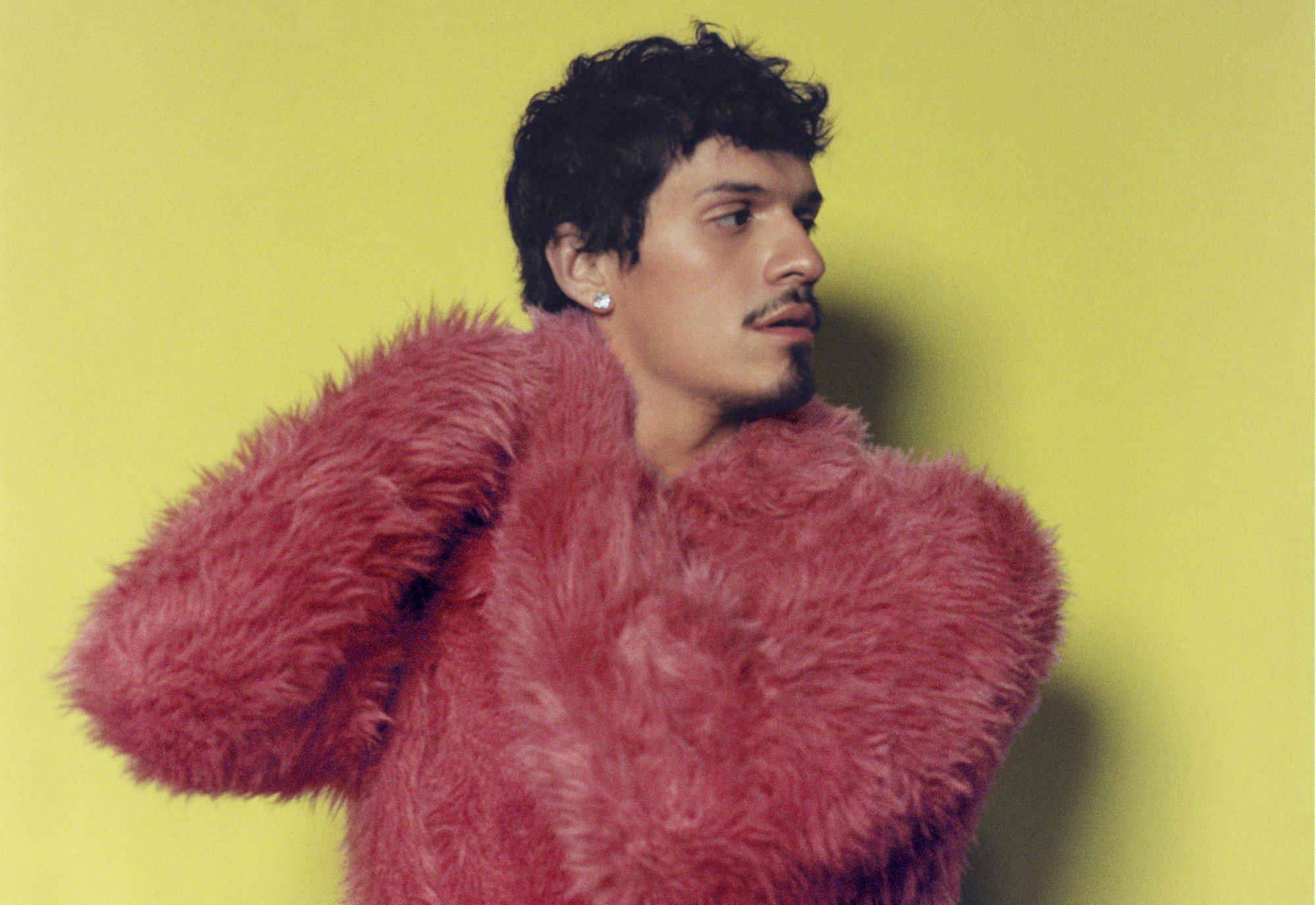
Photo: Aitor Laspiur
interview
Omar Apollo Embraces Heartbreak And Enters His "Zaddy" Era On 'God Said No'
Alongside producer Teo Halm, Omar Apollo discusses creating 'God Said No' in London, the role of poetry in the writing process, and eventually finding comfort in the record's "proof of pain."
"Honestly, I feel like a zaddy," Omar Apollo says with a roguish grin, "because I'm 6'5" so, like, you can run up in my arms and stay there, you know what I mean?"
As a bonafide R&B sensation and one of the internet’s favorite boyfriends, Apollo is likely used to the labels, attention and online swooning that come with modern fame. But in this instance, there’s a valid reason for asking about his particular brand of "zaddyhood": he’s been turned into a Bratz doll.
In the middle of June, the popular toy company blasted a video to its nearly 5 million social media followers showing off the singer as a real-life Bratz Boy — the plastic version draped in a long fur coat (shirtless, naturally), with a blinged-out cross necklace and matching silver earrings as he belts out his 2023 single "3 Boys" from a smoke-covered stage.
The video, which was captioned "Zaddy coded," promptly went viral, helped along by an amused Apollo reposting the clip to his own Instagram Story. "It was so funny," he adds. "And it's so accurate; that's literally how my shows go. It made me look so glamorous, I loved it."
The unexpected viral moment came with rather auspicious timing, considering Apollo is prepping for the release of his hotly anticipated sophomore album. God Said No arrives June 28 via Warner Records.
In fact, the star is so busy with the roll-out that, on the afternoon of our interview, he’s FaceTiming from the back of a car. The day prior, he’d filmed the music video for "Done With You," the album’s next single. Now he’s headed to the airport to jet off to Paris, where he’ll be photographed front row at the LOEWE SS25 men’s runway show in between Sabrina Carpenter and Mustafa — the latter of whom is one of the few collaborators featured on God Said No.
Apollo’s trusted co-writer and producer, Teo Halm, is also joining the conversation from his home studio in L.A. In between amassing credits for Beyoncé (The Lion King: The Gift), Rosalía and J Balvin (the Latin GRAMMY-winning "Con Altura"), SZA ("Notice Me" and "Open Arms" featuring Travis Scott) and others, the 25-year-old virtuoso behind the boards had teamed up with Apollo on multiple occasions. Notably, the two collabed on "Evergreen (You Didn’t Deserve Me At All)," which helped Apollo score his nomination for Best New Artist at the 2023 GRAMMYs.
In the wake of that triumph, Apollo doubled down on their creative chemistry by asking Halm to executive produce God Said No. (The producer is also quick to second his pal’s magnetic mystique: "Don't get it twisted, he's zaddy, for sure.")
Apollo bares his soul like never before across the album’s 14 tracks, as he processes the bitter end of a two-year relationship with an unnamed paramour. The resulting portrait of heartbreak is a new level of emotional exposure for a singer already known for his unguarded vulnerability and naked candor. (He commissioned artist Doron Langberg to paint a revealing portrait of him for the cover of his 2023 EP Live For Me, and unapologetically included a painting of his erect penis as the back cover of the vinyl release.)
On lead single "Spite," he’s pulled between longing and resentment in the wake of the break-up over a bouncing guitar riff. Second single "Dispose of Me" finds Apollo heartsick and feeling abandoned as he laments, "It don’t matter if it’s 25 years, 25 months/ It don’t matter if it’s 25 days, it was real love/ We got too much history/ So don’t just dispose of me."
Elsewhere, the singer offers the stunning admission that "I would’ve married you" on album cut "Life’s Unfair." Then, on the very next song — the bumping, braggadocious "Against Me" — Apollo grapples with the reality that he’s been permanently altered by the love affair while on the prowl for a rebound. "I cannot act like I’m average/ You know that I am the baddest bitch," he proclaims on the opening verse, only to later admit, "I’ve changed so much, but have you heard?/ I can’t move how I used to."
More Omar Apollo News & Videos
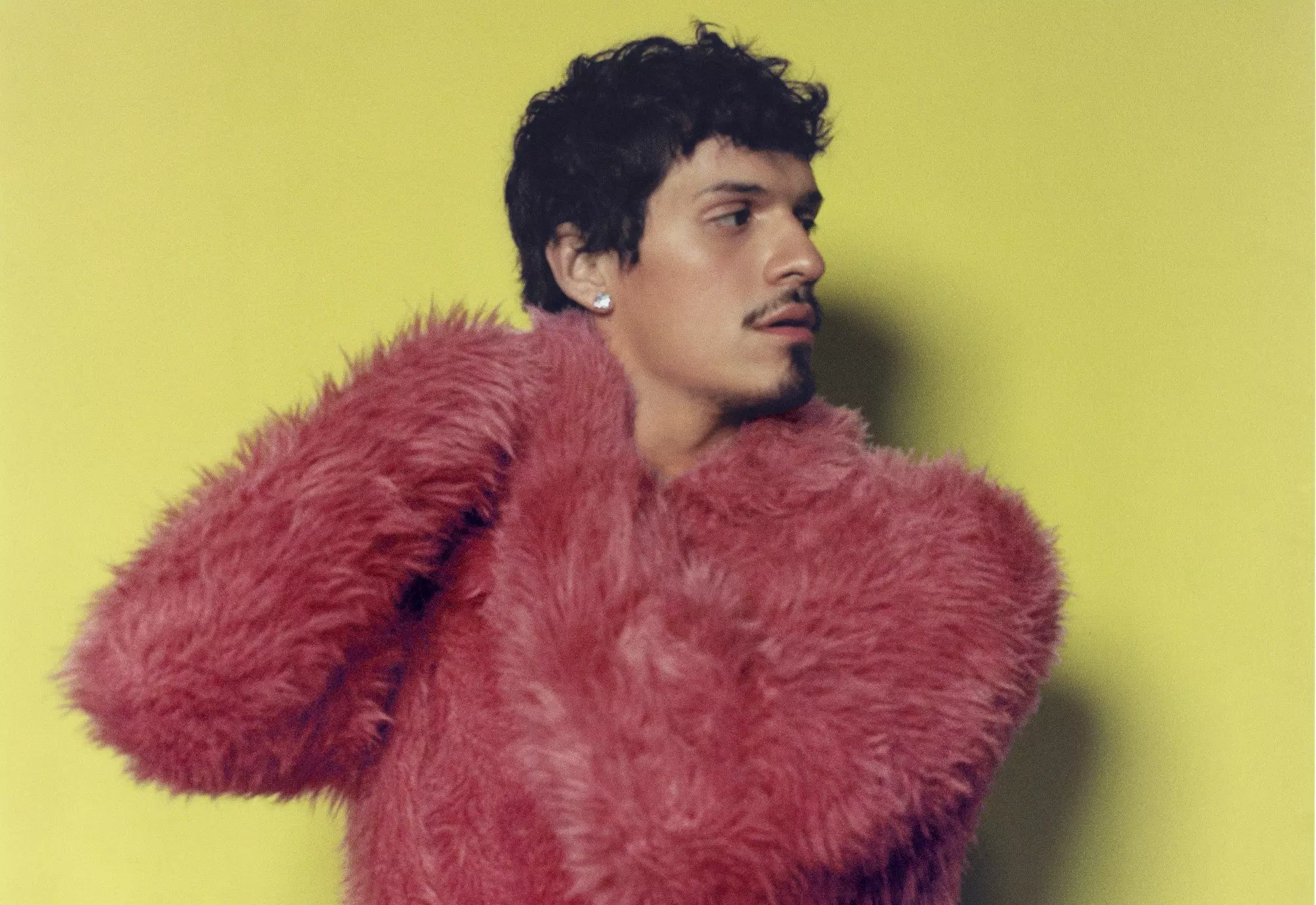
Omar Apollo Embraces Heartbreak And Enters His "Zaddy" Era On 'God Said No'
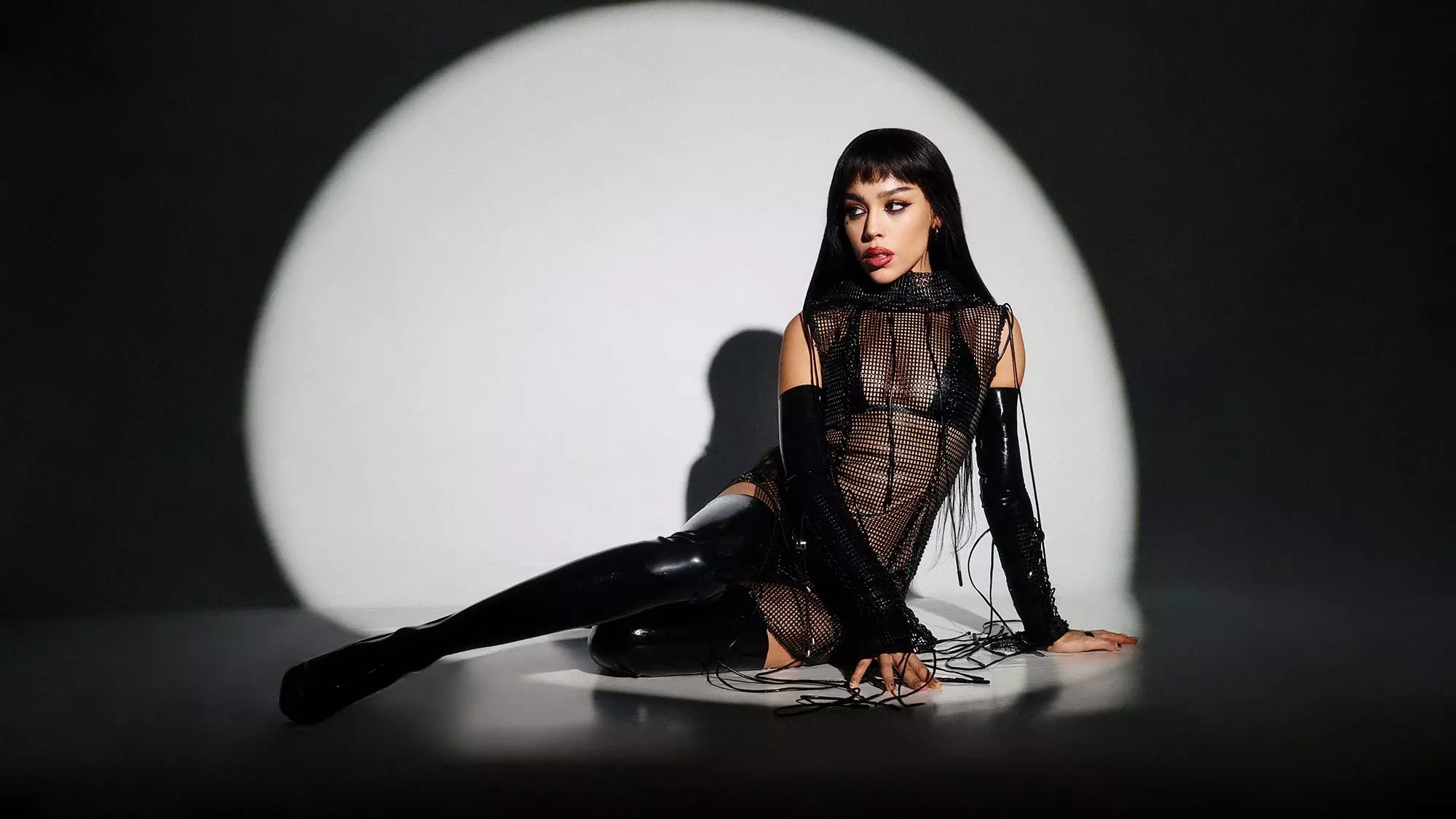
How Danna Paola Created 'CHILDSTAR' By Deconstructing Herself

On Omar Apollo's New EP 'Live for Me,’ Limitless Experimentation Created Catharsis
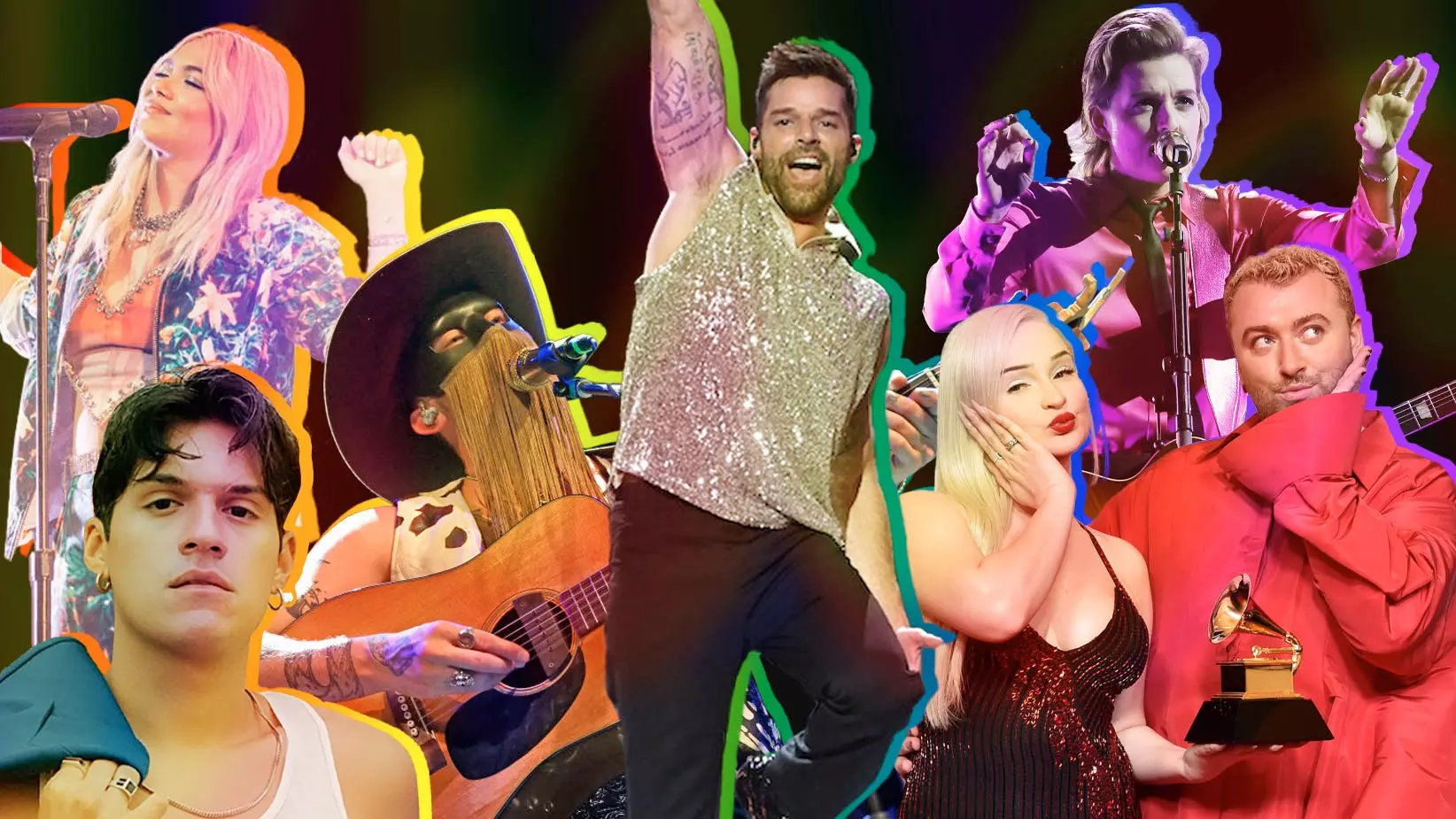
Listen To GRAMMY.com's LGBTQIA+ Pride Month 2023 Playlist Featuring Demi Lovato, Sam Smith, Kim Petras, Frank Ocean, Omar Apollo & More

Omar Apollo On “Evergreen,” Growth & Longing
Given the personal subject matter filling God Said No — not to mention the amount of acclaim he earned with Ivory — it would be understandable if Apollo felt a degree of pressure or anxiety when it came to crafting his sophomore studio set. But according to the singer, that was entirely not the case.
"I feel like I wouldn’t be able to make art if I felt pressure," he says. "Why would I be nervous about going back and making more music? If anything, I'm more excited and my mind is opened up in a whole other way and I've learned so much."
In order to throw his entire focus into the album’s creation, Apollo invited Halm to join him in London. The duo set up shop in the famous Abbey Road Studios, where the singer often spent 12- to 13-hour days attempting to exorcize his heartbreak fueled by a steady stream of Aperol spritzes and cigarettes.
The change of scenery infused the music with new sonic possibilities, like the kinetic synths and pulsating bass line that set flight to "Less of You." Apollo and Halm agree that the single was directly inspired by London’s unique energy.
"It's so funny because we were out there in London, but we weren't poppin' out at all," the Halm says. "Our London scene was really just, like, studio, food. Omar was a frickin' beast. He was hitting the gym every day…. But it was more like feeding off the culture on a day-to-day basis. Like, literally just on the walk to the studio or something as simple as getting a little coffee. I don't think that song would've happened in L.A."
Poetry played a surprisingly vital role in the album’s creation as well, with Apollo littering the studio with collections by "all of the greats," including the likes of Ocean Vuong, Victoria Chang, Philip Larkin, Alan Ginsberg, Mary Oliver and more.
"Could you imagine making films, but never watching a film?" the singer posits, turning his appreciation for the written art form into a metaphor about cinema. "Imagine if I never saw [films by] the greats, the beauty of words and language, and how it's manipulated and how it flows. So I was so inspired."
Perhaps a natural result of consuming so much poetic prose, Apollo was also led to experiment with his own writing style. While on a day trip with his parents to the Palace of Versailles, he wrote a poem that ultimately became the soaring album highlight "Plane Trees," which sends the singer’s voice to new, shiver-inducing heights.
"I'd been telling Teo that I wanted to challenge myself vocally and do a power ballad," he says. "But it wasn't coming and we had attempted those songs before. And I was exhausted with writing about love; I was so sick of it. I was like, Argh, I don't want to write anymore songs with this person in my mind."
Instead, the GRAMMY nominee sat on the palace grounds with his parents, listening to his mom tell stories about her childhood spent in Mexico. He challenged himself to write about the majestic plane tree they were sitting under in order to capture the special moment.
Back at the studio, Apollo’s dad asked Halm to simply "make a beat" and, soon enough, the singer was setting his poem to music. (Later, Mustafa’s hushed coda perfected the song’s denouement as the final piece of the puzzle.) And if Apollo’s dad is at least partially responsible for how "Plane Trees" turned out, his mom can take some credit for a different song on the album — that’s her voice, recorded beneath the same plane tree, on the outro of delicate closer "Glow."
Both the artist and the producer ward off any lingering expectations that a happy ending will arrive by the time "Glow" fades to black, however. "The music that we make walks a tightrope of balancing beauty and tragedy," Halm says. "It's always got this optimism in it, but it's never just, like, one-stop shop happy. It's always got this inevitable pain that just life has.
"You know, even if maybe there wasn't peace in the end for Omar, or if that wasn't his full journey with getting through that pain, I think a lot of people are dealing with broken hearts who it really is going to help," the producer continues. "I can only just hope that the music imparts leaving people with hope."
Apollo agrees that God Said No contains a "hopeful thread," even if his perspective on the project remains achingly visceral. Did making the album help heal his broken heart? "No," he says with a sad smile on his face. "But it is proof of pain. And it’s a beautiful thing that is immortalized now, forever.
"One day, I can look back at it and be like, Wow, what a beautiful thing I experienced. But yeah, no, it didn't help me," he says with a laugh.
Latest News & Exclusive Videos

2024 Paris Olympics Opening Ceremony: Watch Celine Dion, Lady Gaga, Gojira & More Perform

Ice Spice Is The Drill Queen On 'Y2K!': 5 Takeaways From Her Debut Album

New Music Friday: Listen To New Songs From Halsey, MGK And Jelly Roll, XG & More

Watch Young MC Win Best Rap Performance In 1990

The Red Clay Strays Offer A New Kind Of Religion With 'Made By These Moments'

Photo: Gary Miller/Getty Images
list
Inside Neil Young & Crazy Horse's 'F##IN' UP': Where All 9 Songs Came From
Two-time GRAMMY winner and 28-time nominee Neil Young is back with 'F##IN' UP,' another album of re-recorded oldies, this time with Crazy Horse. But if that sounds like old hat, this is Young — and the script is flipped yet again.
Neil Young has never stopped writing songs, but for almost a decade, he's been stringing together old songs like paper lanterns, and observing how their hues harmonize.
2016's Earth, where live performances of ecologically themed songs were interspersed with animal and nature sounds, was certainly one of his most bizarre. 2018's Paradox, a soundtrack to said experimental film with wife/collaborator Darryl Hannah, took a similarly off-kilter tack.
He's played it straight for others. Homegrown and Chrome Dreams were recorded in the ‘70s, then shelved, and stripped for parts. Both were finally released in their original forms over the past few years; while most of the songs were familiar, it was fascinating envisioning an alternate Neil timeline where they were properly released.
Last year's Before and After — likely recorded live on a recent West Coast solo tour — was less a collection of oldies than a spyglass into his consciousness: this is how Young thinks of these decades-old songs at 78.
Now, we have F##IN' UP, recorded at a secret show in Toronto with the current version of Crazy Horse. (That's decades-long auxiliary Horseman Nils Lofgren, or recent one Micah Nelson on second guitar, with bassist Billy Talbot and drummer Ralph Molina from the original lineup.)
Every song's been christened an informal new title, drawn from the lyrics; the effect is of turning over a mossy rock to reveal its smooth, untouched inverse.
It's named after a fan favorite from 1990's Ragged Glory; in fact, all of its songs stem from that back-to-the-garage reset album. Of course, that's how they relate; they're drawn from a single source. But Young being Young, it's not that simple: some of these nine songs have had a long, strange journey to F##IN' UP.
Before you see Neil and the Horse on tour across the U.S., here's the breakdown.
"City Life" ("Country Home")
The Horse bolts out of the gate with "Country Home," from Ragged Glory; in 2002's Shakey, Young biographer Jimmy McDonough characterized it as "a tribute to the [Broken Arrow] ranch that is surely one of Young's most euphoric songs."
As McDonough points out, it dates back to the '70s, around the Zuma period. With spring sprung, another go-round of this wooly, bucolic rocker feels right on time.
"Feels Like a Railroad (River Of Pride)" ("White Line")
Like "Country Home," "White Line" also dates back to the mid-'70s — but we've gotten to hear the original version, as released on 2020's (via-1974-and-'75) Homegrown.
The original was an aching acoustic duet with the Band's Robbie Robertson; when the Horse kicks it in the ass, it's just as powerful. (As for Homegrown, it was shelved in favor of the funereal classic Tonight's the Night.)
"Heart Of Steel" ("F##in' Up")
As with almost every Horse jam out there, the title track to F##IN' UP defies analysis. Think of a reverse car wash: the uglier and grungier the Horse renders this song, the more beautiful it is.
"Broken Circle" ("Over and Over")
Title-wise, it’s excusable if you mix this one up with "Round and Round," a round-robin deep cut from the first Neil and the Horse album, 1969's Everybody Knows This is Nowhere. Rather, this is yet another sturdy, loping rocker from Ragged Glory.
"Valley of Hearts" ("Love to Burn")
As McDonough points out in Shakey, "Love to Burn" has an acrid, accusatory edge that might slot it next to "Stupid Girl" in the pantheon of Neil's Mad At An Ex jams: "Where you takin' my kid / Why'd you ruin my life?"
But the chorus salves the burn: "You better take your chance on love / You got to let your guard down."
"She Moves Me" ("Farmer John")
The only non-Young original on F##IN' UP speaks to his lifelong inspiration from Black R&B music — a flavor OG guitarist Danny Whitten brought to the Horse, and has persisted in their sound decades after his tragic death.
Don "Sugarcane" Harris and Dewey Terry wrote "Farmer John" for their duo Don and Dewey; it dates back to Young's pre-Buffalo Springfield surf-band the Squires.
"Not much of a tune, but we made it happen," Bill Edmundson, who drummed with the band for a time, said in Shakey. "We kept that song goin' for 10 minutes. People just never wanted it to end." Sound familiar?
"Walkin' in My Place (Road of Tears)" ("Mansion on the Hill")
"Mansion on the Hill" was one of two singles from Ragged Glory; "Over and Over" was the other.
While it's mostly just another Ragged Glory rocker with tossed-off, goofy lyrics, Young clearly felt something potent stirring within its DNA; back in the early '90s, he stripped it down for acoustic guitar on the Harvest Moon tour.
"To Follow One's Own Dream" ("Days That Used To Be")
Briefly called "Letter to Bob," "Days That Used to Be" is Dylanesque in every way — from its circular, folkloric melody to its shimmering, multidimensional lyrics.
"But possessions and concession are not often what they seem/ They drag you down and load you down in disguise of security" could be yanked straight from Blonde on Blonde.
For more of Young's thoughts on Bob Dylan, consult "Twisted Road," from his 2012 masterpiece with the Horse, Psychedelic Pill. "Poetry rolling off his tongue/ Like Hank Williams chewing bubble gum," he sings, sounding like a still-awestruck fan rather than a peer.
"A Chance On Love" ("Love and Only Love")
Possibly the most resonant song on Ragged Glory — and, by extension, F##IN' UP — "Love and Only Love" is like the final boss of the album, where Young battles hate and division with Old Black as his battleaxe.
(Also see: Psychedelic Pill's "Walk Like a Giant," where Young violently squares up with the '60s dream.)
The 15-minute workout (which feels like Ramones brevity in Horse Time) It's a fitting end to F##IN' UP. There will be more Young soon. A lot more, his team promises. But although his output is a firehose, take it under advisement to savor every last drop.
Inside Neil Young's Before and After: Where All 13 Songs Came From
.jpg)
Photo: Michael Kovac/Getty Images for The Recording Academy
video
GRAMMY Rewind: Watch Beyoncé's Heartfelt Speech For Her Record-Breaking Win In 2023
Relive the night Beyoncé received a gramophone for Best Dance/Electronic Album for 'RENAISSANCE' at the 2023 GRAMMYS — the award that made her the most decorated musician in GRAMMY history.
Six years after her last solo studio album, Beyoncé returned to the music industry with a bang thanks to RENAISSANCE. In homage to her late Uncle Johnny, she created a work of art inspired by the sounds of disco and house that wasn't just culturally impactful — it was history-making.
At the 2023 GRAMMYs, RENAISSANCE won Best Dance/Electronic Album. Marking Beyoncé's 32nd golden gramophone, the win gave the superstar the record for most gramophones won by an individual act.
In this episode of GRAMMY Rewind, revisit the historic moment Queen Bey took the stage to accept her record-breaking GRAMMY at the 65th Annual GRAMMY Awards.
"Thank you so much. I'm trying not to be too emotional," Beyoncé said at the start of her acceptance speech. "I'm just trying to receive this night."
With a deep breath, she began to list her praises that included God, her family, and the Recording Academy for their continued support throughout her career.
"I'd like to thank my Uncle Johnny, who is not here, but he's here in spirit," Beyoncé proclaimed. "I'd like to thank the queer community for your love and inventing this genre."
Watch the video above for Beyoncé's full speech for Best Dance/Electronic Album at the 2023 GRAMMYs. Check back to GRAMMY.com for more new episodes of GRAMMY Rewind.
Tune into the 2024 GRAMMYs on Sunday, Feb. 4, airing live on the CBS Television Network (8-11:30 p.m. LIVE ET/5-8:30 p.m. LIVE PT) and streaming on Paramount+ (live and on-demand for Paramount+ with SHOWTIME subscribers, or on-demand for Paramount+ Essential subscribers the day after the special airs).
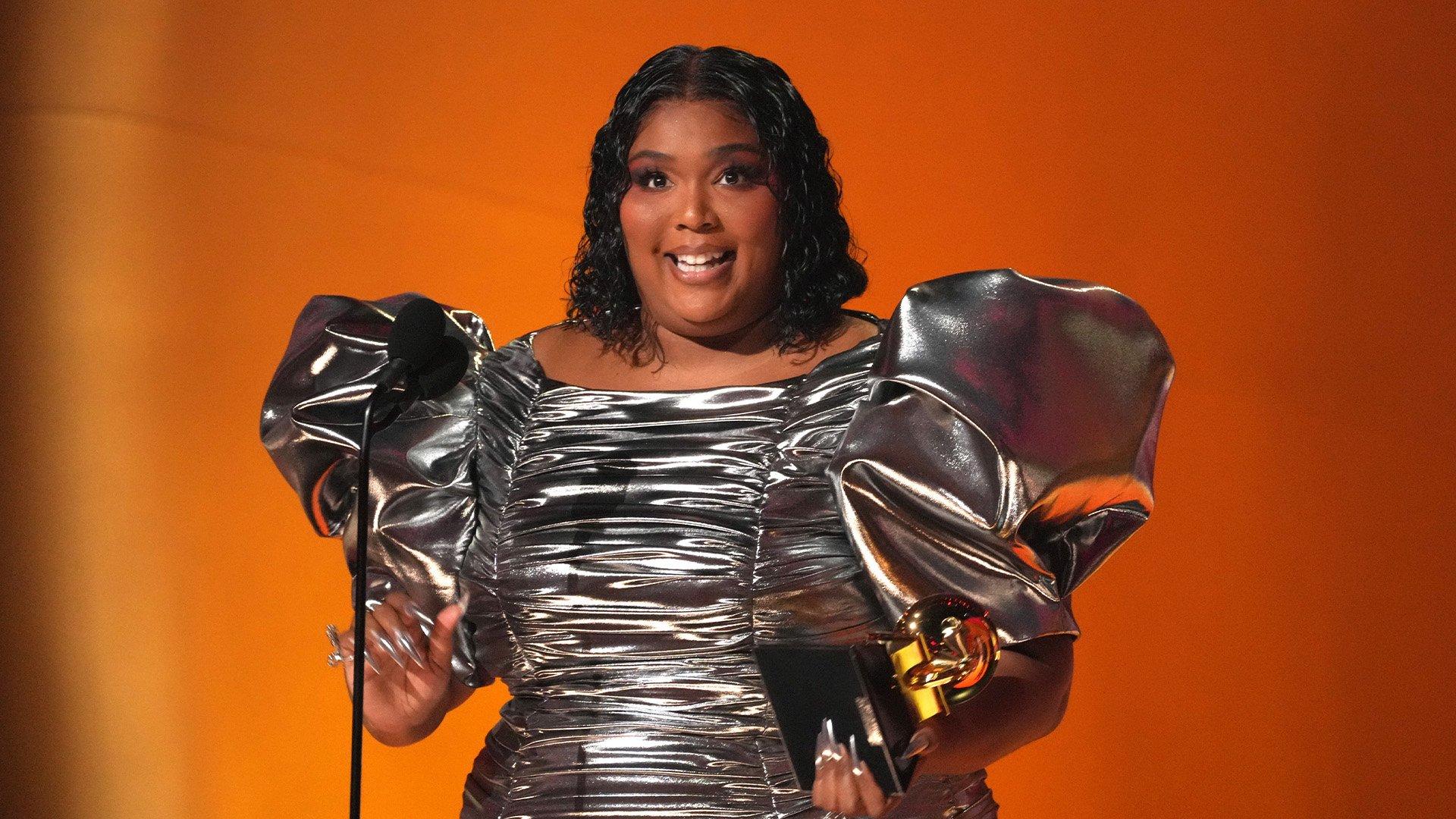
Photo: Kevin Mazur/Getty Images for The Recording Academy
video
GRAMMY Rewind: Lizzo Thanks Prince For His Influence After "About Damn Time" Wins Record Of The Year In 2023
Watch Lizzo describe how Prince’s empowering sound led her to “dedicate my life to positive music” during her Record Of The Year acceptance speech for “About Damn Time” at the 2023 GRAMMYs.
Since the start of her career, four-time GRAMMY winner Lizzo has been making music that radiates positive energy. Her Record Of The Year win for "About Damn Time" at the 2023 GRAMMYs proved that being true to yourself and kind to one another always wins.
Travel back to revisit the moment Lizzo won her award in the coveted category in this episode of GRAMMY Rewind.
"Um, huh?" Lizzo exclaimed at the start of her acceptance speech. "Let me tell you something. Me and Adele are having a good time, just enjoying ourselves and rooting for our friends. So, this is an amazing night. This is so unexpected."
Lizzo kicked off her GRAMMY acceptance speech by acknowledging Prince's influence on her sound. "When we lost Prince, I decided to dedicate my life to making positive music," she said. "This was at a time when positive music and feel-good music wasn't mainstream at that point and I felt very misunderstood. I felt on the outside looking in. But I stayed true to myself because I wanted to make the world a better place so I had to be that change."
As tracks like "Good as Hell" and "Truth Hurts" scaled the charts, she noticed more body positivity and self-love anthems from other artists. "I'm just so proud to be a part of it," she cheered.
Most importantly, Lizzo credited staying true to herself despite the pushback for her win. "I promise that you will attract people in your life who believe in you and support you," she said in front of a tearful audience that included Beyoncé and Taylor Swift in standing ovation, before giving a shout-out to her team, family, partner and producers on the record, Blake Slatkin and Ricky Reed.
Watch the video above for Lizzo's complete acceptance speech for Record Of The Year at the 2023 GRAMMYs. Check back to GRAMMY.com for more new episodes of GRAMMY Rewind, and be sure to tune into the 2024 GRAMMYs on Sunday, Feb. 4, airing live on the CBS Television Network (8-11:30 p.m. LIVE ET/5-8:30 p.m. LIVE PT) and streaming on Paramount+ (live and on-demand for Paramount+ with SHOWTIME subscribers, or on-demand for Paramount+ Essential subscribers the day after the special airs).
